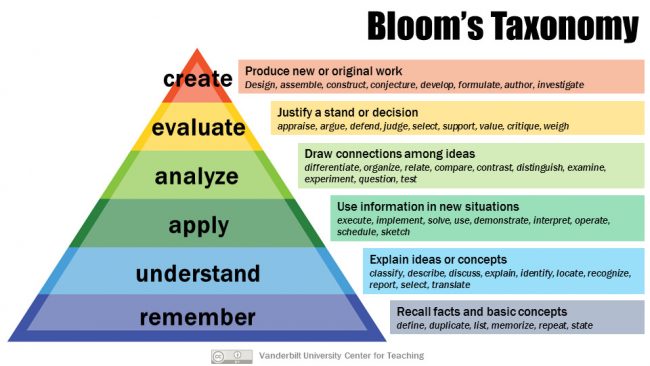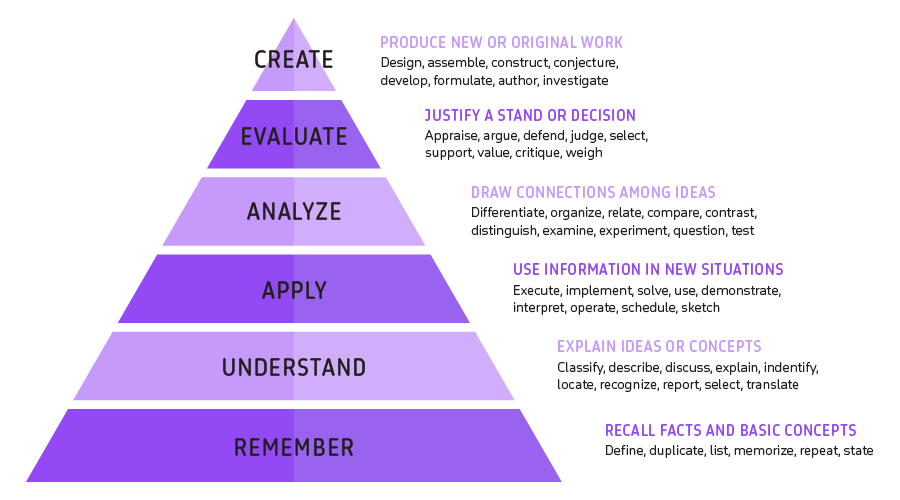Bloom's Taxonomy Is Best Described as Providing ______
Understanding what the facts mean. Blooms taxonomy considers such higher and lower order understanding and analytical skills.

Bloom S Taxonomy Center For Teaching Vanderbilt University
Blooms taxonomy is considered a three-rank hierarchical model.

. The Blooms Taxonomy framework allows educators to assess learning on an ongoing basis encouraging students to reflect on their progress. There are a number of reasons why a teacher would want to use Blooms taxonomy. For example on a course focused at the lower levels of learning an activity that involves analysis or creation may be unsuitable.
Educators have typically used Blooms taxonomy to inform or guide the development of assessments tests and other evaluations of student learning curriculum units lessons projects and other learning. Blooms Taxonomy is a classification of the different objectives and skills that educators set for their students learning objectives. The word taxonomy simply means classifications or structures.
It is one of the most widely used and often cited works of education 1. Blooms Taxonomy A classification of six levels of intellectual behavior important in learning. Knowledge comprehension application analysis synthesis and evaluation.
Blooms Taxonomy is a classification system developed by educational psychologist Benjamin Bloom to categorize cognitive skills and learning behavior. Developing critical thinking and problem-solving skills by providing activities to broaden and deepen knowledge beyond the regular curriculum. Blooms Taxonomy is a multi-tiered model of classifying thinking according to six cognitive levels of complexity 1.
Blooms Taxonomy is best described as providing _____. Provides a common language among educators. Blooms Taxonomy of Measurable Verbs Benjamin Bloom created a taxonomy of measurable verbs to help us describe and classify observable knowledge skills attitudes behaviors and abilities.
Also it is helpful in learning. The actions associated with each level of Blooms learning hierarchy remembering understanding applying analyzing synthesizingevaluating and creating reflect both educational goals and. Blooms taxonomy is the backbone of most CME and residency programs lesson plans assessments simulations and learning platformsincluding NEJM Knowledge.
Blooms Taxonomy is a method created by Benjamin Bloom to categorize the levels of reasoning skills that students use for active learning. They are helpful because some verbs are appropriate at a particular level. According to the revised version of Blooms Taxonomy there are six cognitive learning.
Blooms Taxonomy classifies thinking according to six cognitive levels of complexity. Blooms taxonomy primarily provides instructors with a focus for developing their course learning outcomes. The levels of thinking in Blooms taxonomy.
Many teachers write their assessments in the lowest two levels of the taxonomy. Let us study Blooms taxonomy examples along with its details. These six levels are applying remembering analyzing understanding creating and evaluating.
The terminology has been recently updated to include the following six levels of learning. Knowledge comprehension application analysis synthesis and evaluation. Rote memorization recognition or recall of facts.
Blooms taxonomy helps educators create appropriate learning activities for the level of learning that is taking place. Blooms Taxonomy is a hierarchical model that categorizes learning objectives into varying levels of complexity from basic knowledge and comprehension to advanced evaluation and creation. Blooms Taxonomy comprises three learning domains.
They are hierarchical in nature meaning that students must master the content at each of the lower levels before moving to the next highest level. Blooms taxonomy can serve many purposes. There are six levels of Blooms Taxonomy.
Blooms Revised Taxonomys Usage in Assessment. Distinctions between higher and lower levels of thinking. Blooms taxonomy helps instructions set the activities at the right level.
Correct use of the facts rules or ideas. Initially it can be used to increase ones understanding of the educational process. Blooms Taxonomy is essential because it helps educators identify achievable learning goals and develop plans to meet them.
It talks about the skills of thinking and analyzing by following a particular order. The theory is based upon the idea that there are levels of observable actions that indicate something is happening in the brain cognitive activity. Cognitive affective and psychomotor.
Blooms Taxonomy is a classification system used to define and distinguish different levels of human cognition i. Breaking down information into component parts. According to Benjamin Bloom and his colleagues there are six levels of cognition.
E thinking learning and understanding. The taxonomy was proposed in 1956 by Benjamin Bloom an educational psychologist at the University of Chicago.

Bloom S Taxonomy What Is It And How It Can Be Applied Effectively To Develop Critical Thinking Skills London School Of Management Education

Ultimate Guide To Implementing Bloom S Taxonomy In Your Course Top Hat

Ch 8 Bloom S Taxonomy Instructional Methods Strategies And Technologies To Meet The Needs Of All Learners
Comments
Post a Comment